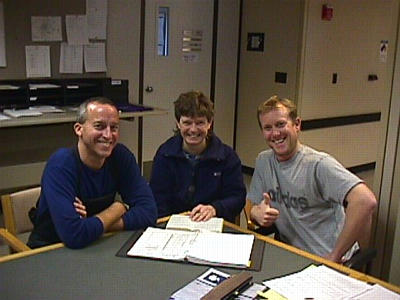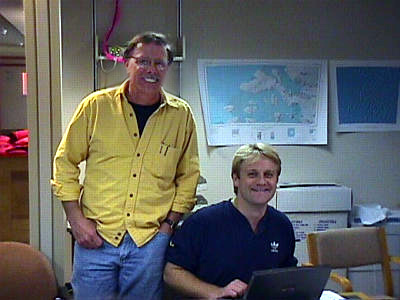1 December, 1998
Tuesday, December 1st, 1998
Hi everyone! This morning Peter Webb, one of the head scientists for the Cape
Roberts Project, gave a wonderful slide presentation at 9:30 AM. His talk and
slides featured the Dry Valleys of Antarctica. Since small groups from the
CRP are going to be taking night time field trips to the Dry Valleys starting
this week, he wanted to give some background on this area of Antarctica. The
Dry Valleys are unique for many reasons, but one important thing to know is
that this area has not had rain in at least two million years. The valleys
are HUGE, deserted, and are supposed to be quite beautiful. I will be finding
out for myself very soon!
When Peter was finished, several different teams of CRP gave short
presentations about their findings so far. More talk also centered around the
initial reports which each science team needs to be writing. These reports
must be turned in to an editorial committee before scientists leave
Antarctica. It is not just the sampling and scientific studies that take
place here…the results are published in a journal and shared with scientists
around the world.
I spent a lot of time today working on a new project. I took the samples that
have been heated or measured on the magnetometer, and put these BACK into the
small plastic bags that are labeled with the depth of the core at which the
samples were taken. Considering that we have a little over 1,000 samples in
the lab right now…that is a huge task. I bet I re-bagged close to 300
cylindrical samples today and tonight. I also pitched in and helped with the
demagnetizer when my teammates running the magnetometer needed help. I was in
the lab a LONG time today. I finally quit about 10:30 PM.
Earlier today, I had the chance to continue my interviews with Cape Roberts
scientists and I spent some time with the sedimentologists…parcticularly Tim
Naish. He filled me in on what the various sedimentologists do as part of
this project. Let me share this information with you. Out at the drill site
and Cape Roberts camp, Ross Powell does the initial core logging and Ken Wolfe
does the computer generated core log. Mark Lavalle assists Ken with the
computer generated logs as well. Werner Ehrmann helped part of the time with
initial core logging, and later worked on clay mineralogy. Michele Clapps
worked the first half of the time on cyclostratigraphy, which is looking at
small scale sedimentary cycles-or patterns-in the core. He spent the other
half of his time working on the initial core log with Ross.
Cliff Atkins split his time between the Cape Roberts camp and drill site.
While out at Cape Roberts, he worked on core description. Back in Crary Lab,
Cliff is studying the "clasts" by analyzing whole round sections of
core…looking at sections of core that contain the clasts, before the core is
cut in half. Clasts can be pebbles, cobbles, and boulders that are deposited
in sediments. In this case, the clasts Cliff studies are considered pebbles-
no more than about 6 cm in diameter. He looks at the whole clast and does a
shape analysis of it. This means he looks at the roundness of the pebbles,
whether or not they have flat surfaces, and whether they have striations
(glacial grooves) in them. By studying all these things, Cliff can tell
whether or not the pebbles have been in glaciers or not, and he can measure
the orientation of the clasts (the direction and tilt of each).
Once the boxes of core arrived in McMurdo, Chris Fielding completely re-logs
the core, without looking at the sheets that were logged out at Cape Roberts.
This serves several purposes, but most important, it is a good check to see
that the logs agree (between Cape Roberts scientists and those here in Crary
Lab). Larry Krissek checks over the logs that are written out at Cape Roberts
and goes over the lithologic boundaries (changes in the types of sediment).
Chris and Larry have an additional responsibility…Chris presented the core and
described it IN DETAIL each morning while he showed us the boxes of core in
the sampling lab. Larry discussed the lithologic boundaries with the
scientists of CRP. These were two major components of our daily meetings on
CRP.
Tim Naish works on interpretation of the logs (more than just the
descriptions) and he interprets the core in terms of changes in environment.
Jaap Van Der Meer studies glacial deformation…which means he gives a glacial
history of the advance and retreat of glaciers over a certain part of the sea
floor. Finally, Fulvia Aghiv studies diogenesis-chemical reactions that occur
in the sediments once they're deposited and buried.
This is just ONE of the important science teams involved in the Cape Roberts
Project. As I interview the scientists, I continue to learn more about
geology and this very complex drilling project. Hope you learned something,
too! Thanks to Tim Naish and Cliff Atkins for the interview and valuable
information. Talk to you tomorrow!
Betty :)

(from left to right) Larry Krissek, Chris Fielding, and Tim Naish...part of the team of sedimentologists working on the Cape Roberts Project.

(from left to right) Ross Powell and Cliff Atkins, sedimentologists with CRP.

Here I am in the lab, re-bagging our cylindrical samples.
Contact the TEA in the field at
.
If you cannot connect through your browser, copy the
TEA's e-mail address in the "To:" line of
your favorite e-mail package.
|
